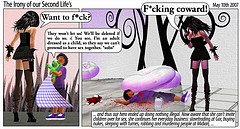And so it came to pass, that the Lindens saw that they couldn’t afford to support two grids at the same time, and lo and behold! The Teen Grid was no more, and teens were allowed to enter the Main Grid. And the Lindens saw that it was good.
Well, perhaps. Residents, however, have a slightly different opinion, as can be seen by the more than thousand comments on Terrence Linden’s announcement of the upcoming end of the Teen Grid. After years and years of reinforcing the idea that teens and adults would never mingle, Philip finally had to revert the ‘Lab’s standing policy on the clear separation between adults and teens. For now, after January 1st, 2011, only 16 and 17-year olds will be allowed on the Main Grid, but both Philip and Terrence have promised that they would work a solution to allow the 13 to 15-year olds a way to access the Main Grid as well at a later stage.
This is a surprising turn of events, since it has always been a strong policy to keep teens off the grid, no matter what. The main reason is, of course, purely financial: Linden Lab, continuing its policy of downsizing, is cutting costs wherever it can, and making sure the company remains lean and profitable. Keeping two grids, specially one that had few residents (comparatively speaking), didn’t make much sense.
Linden Lab could have simply shut down Teen Grid and tell all teens that they’re sorry. But the decision was made to incorporate them on the Main Grid. Why? It’s not as if Linden Lab is on a masochistic downwards spiral to destroy Second Life’s community by announcing increasingly more intolerable policies. The truth is, Teen Grid was used by a lot of educators — at least nominally so; teens report that most sims were left empty; but the point is that those educators paid for the sims, no matter how intensely they were used or not — and since LL’s dubious continuing support of the academic and corporate customers, they made a gesture of goodwill towards them.
Let’s look at the positive side first, since it’s often the most neglected one. A virtual world for clever teens is something quite rare, and that’s what actually the Teen Grid was. Of course it had its share of jerks and idiots — but these would come and go. A few remained, and those have the unusual characteristic of being able to self-entertain themselves. They’re creative, talented, and engaged within SL. They always complained how hard it was for them to address the tiny market of TSL, and have now this awesome opportunity to release their creations on a vast world with over a million regular consumers of virtual goods.
A few parents also have manifested the desire to be in-world with their kids. While a lot of people find this odd, I find it very healthy that parents and their children share at least some of their interests. It is a most excellent way to bridge the generation gap. In a sense, “playing with your parents” is something that you stop doing in your teens, for no real reason except a slow change of mindset, where parents start to become strange beings for the hormone-pumped teens that just see them as obstacles in their life of pleasure… but, again, why should this be so? In my (probably conservative) way of thinking, parents and their children are a family that share a lot of things together, and it’s not bad to share common things and do them together. In my teens, I also enjoyed to watch TV and go to the movies with my parents, even though I most often went with my friends. Even in my late twenties I used to go with my mommy to watch blockbusters, because we both love them, and most of my friends were too intellectual and just wanted to see boring French or Italian neo-realist movies… I thank my mother for her open mind and for saving me for the dread of watching 15-minute-scenes with a static camera pointed at a tree or a cloud, and instead being able to enjoy myself while watching Superman 🙂
And finally, of course, there are the educators. An early frustration by several universities which joined SL early on (e.g. in 2006) was that they had lots of projects with high schools and were unable to implement them in SL. Funding for whole educational projects was often rejected because their target audience — teens in high school — was not allowed to see the content in SL. With the ability to certify teachers to log in to Teen SL, this at least enabled some of the projects to thrive, but they were still limited in the amount of content they were allowed to deploy (since they had to do everything from scratch). Merging the two grids allows all these projects to continue to be in SL and will encourage future educational projects to be brought to SL as well. Even some corporate projects that have a younger audience in mind might rethink their virtual world alternatives and put SL on their horizons again.
All the above (including the financial issue) are good reasons for merging the grids instead of just dropping the Teen Grid.
Then there is the reverse side of the coin.





